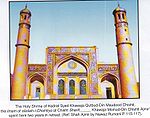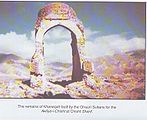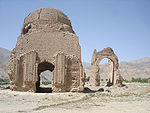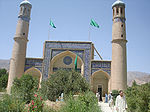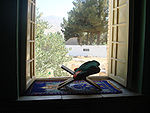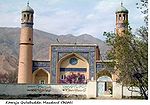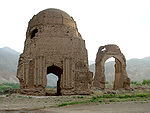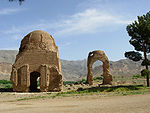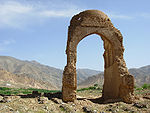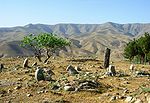- Chisht
-
Chisht, also written Chisht-e Sharif, Chesht-i Sharif or Chesht [1][2] is a town near Herat in Afghanistan. It is important in Sufism because the Chishti Sufi Order originated there.
Chisht-i-Sharif is some 177 km from Herat city. As you approach it across a plateau, you can see the two famous domes of Chisht. The town with its meandering bazaar street sits in the ravine between these plateaus. Winding down and up, you will find an avenue of pine trees leading directly to two ruined buildings now standing in the middle of an extensive graveyard. Experts argue as to the purpose of these buildings. Some speak of them as mausoleums. Others see them as parts of a grand complex of buildings. The mutilated molded terra cotta brick decoration can only speak softly their former magnificence. Stylistically, the decoration of these buildings falls into the category of Ghorid arch in the Jami Mosque and the minaret of Jam, both of which bear the name of Ghiyas-ud-din Ghori.
Contents
Images
Chishti Order
The Chishti order of the Sufis derives its name from Chisht (pronounce: Chesht, hence Cheshti). Chisht is a small town near Herat in Afghanistan. The first one to call himself Chishti was Abu Ishaq Shami. As the name Shami implies he came from Syria or even from Damascus (ash-Sham). He met a Sufi who directed him to settle in Chisht and from that day on he is known as Abu Ishaq Shami Chishti. He died in 940 C.E. in Damascus and lies buried on mount Qasiyun, where later on also Ibn al-‘Arabi was buried. Looking at the date of his death we can say that the Chishtiyya order is one of the oldest, if not the oldest now still existing Sufi order.
The next in the silsila of the Chishtiyya is Khwaja Mawdud Chishti. He had learnt the Qur’an by heart and could recite it very melodiously at the age of seven. Afterwards he learned the other things. When he was only 26 years old his father’s life came to an end. According to the will of his father he became his successor.
He was born around 430 Hijri in the city of Chisht. He initially received education from his father. He memorized Qur'an by the age of 7, and completed his education when he was 16.
His work includes two books Minhaaj ul Arifeen and Khulaasat ul Shariah.
He died around Rajab 527 Hijri and is buried in Chisht.
See also
- Kirani
- Gulzar
- Abu Yusuf Bin Saamaan
- Khwaja Najamuddin Ahmed
- Khwaja Hussain Chishti
- Khwaja Qutubuddin
- Shaal Pir Baba Khwaja Naqruddin
- Khwaja Wali Kirani
- Khwaja Ibrahim Yukpasi
References
- The Big Five of India in Sufism [1]
- Pakistan, a Political Study [2]
- A Guide to the Islamic Movement [3]
- Tazkara-e-Syed Moudodi,idara-e-maarife Islam, Mansoora Lahore
- Sair-ul-aolia,Urdu and Persian edition, written by Amir Khurd
- Maraat-ul-israr by Hazrat Khwaja Abdul Rehman Chishti Quds Sira
- Trirekh-e-mashaikh-e-Chisht by Doctor inam-ul-Haq
- Safinat-ul-Arifeen
- Tazkara-e-Ghuas o Qutub
- Shijra-e-Maoroosi Sadat Kirani
- The mashkiah of Chisht by Shiekh Muhammed Zakariyya Kandhalwi
- The Origin Of Chishti Order
External links
- Dupree, Nancy Hatch (1977): An Historical Guide to Afghanistan. 1st Edition: 1970. 2nd Edition. Revised and Enlarged. Afghan Tourist Organization. [4]
References
- ^ http://www.archnet.org/library/places/one-place.jsp?place_id=10162&order_by=title, accessed 19. January 2010
- ^ http://spach.info/ephotosheratchist-esharif.htm, accessed 19. January 2010
Coordinates: 34°21′N 63°44′E / 34.35°N 63.733°E
Capital 
Districts Adraskan · Chishti Sharif · Farsi · Ghoryan · Gulran · Guzara · Hirat · Injil · Karukh · Kohsan · Kushk · Kushki Kuhna · Obe · Pashtun Zarghun · Shindand · Zinda JanCities Adraskan · Azizabad · Baluchi · Bazargan · Chisht · Chishti Sharif · Farsi · Ghurian · Gulran · Guzara · Herat · Injil · Islam Qala · Karukh · Kohsan · Kushk · Kushki Kuhna · Obe · Pashtun Zarghun · Sabzawar · Shindand · Towraghondi · Zendeh Jan ·Landmarks Herat citadel · Khwaja 'Abd Allah Ansari shrine · Friday Mosque of Herat · Tomb of Queen Goharshad · Herat City Old FortCategories:- Populated places in Herat Province
- Herat Province geography stubs
Wikimedia Foundation. 2010.

